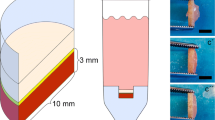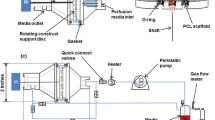Summary
The Rotating-Wall Vessel (RWV) was used to culture chondrocytes for 36 d to observe the influence of low-shear and quiescent culture conditions allowing three-dimensional freedom on growth, differentiation, and extracellular matrix formation. Chondrocytes were freshly isolated from bovine cartilage and placed into the RWV with Cytodex-3 microcarriers. Nonadherent petri dishes were initiated with microcarriers as representative of standard culture conditions. In the RWV, large three-dimensional aggregates (5–7 mm) were formed in suspension. In addition, a large sheet of matrix adhered to the oxygenator core and vessel endcaps. Petri dish culture resulted in the formation of sheets of chondrocytes with no matrix production. Immunocytochemical analyses on histologic sections of tissue obtained from the RWV and the petri dish controls were performed with antibodies against fibronectin, collagen II, chondroitin-4-sulfate, chondroitin-6-sulfate, and vimentin. Results demonstrated increased signal in the RWV material while the petri dishes demonstrated a slight decrease in signal. In addition, differentiated chondrocytes were observed in sections of RWV material through 36 d, while few were observed in the sections of petri dish material. These results indicate that the unique conditions provided by the RWV afford access to cellular processes that signify the initiation of differentiation as well as production of normal matrix material.
Similar content being viewed by others
References
Adams, S. L.; Pallante, K. M.; and Pacifici, M. Effects of cell shape on type X collagen gene expression in hypertrophic chondrocytes. Connect. Tissue Res. 20:223–232; 1989.
Adolphe, M.; Benya, P. Different types of cultured chondrocytes—the in vitro approach to the study of biological regulation. In: Adolphe, M., ed. Biological regulation of the chondrocytes. Boca Raton, FL; CRC Press; 1992:105–139.
Aulthouse, A. L.; Beck, M.; Griffey, E., et al. Expression of the human chondrocyte phenotype in vitro. In Vitro Cell. Dev. Biol. 25:659–668; 1989.
Becker, J. L.; Prewett, T. L.; Spaulding, G. F., et al. Three-dimensional growth and differentiation of ovarian tumor cell line in high-aspect rotating-wall vessel: morphologic and embryologic considerations. J. Cell. Biochem. 51:283–289; 1993.
Benya, P. D.; Brown, P. D.; Padilla, S. R. Microfilament modification by dihydrocytochalasin-B causes retinoic acid-modulated chondrocytes to reexpress the differentiated collagen phenotype without a change in shape. J. Cell Biol. 106:161–170; 1988.
Benya, P. D.; Padilla, S. R.; Nimni, M. E. The progeny of rabbit articular chondrocytes synthesize collagens type I and III and type I trimer, but not type II. Verification by cyanogen bromide peptide analysis. Biochemistry 16:865–872; 1977.
Benya, P. D.; Padilla, S. R.; Nimni, M. E. Independent regulation of collagen types by chondrocytes during the loss of differentiated function in culture. Cell 15:1313–1321; 1978.
Benya, P. D.; Shaffer, J. D. Dedifferentiated chondrocytes reexpress the differentiated collagen phenotype when cultured in agarose gels. Cell 30:215–224; 1982.
Brown, P. D.; Benya, P. D. Alterations in chondrocyte cytoskeletal architecture during phenotypic modulation by retinoic acid and dihydrocytochalasin-B induced reexpression. J. Cell Biol. 106:171–179; 1988.
Caplan, A. I.; Koutroupas, S. The control of muscle and cartilage development in the chick limb: the role of differential vascularization. J. Embryol. Exp. Morphol. 29:571–583; 1973.
Duke, P. J.; Daane, E. L.; Montufar-Solis, D. Studies of chondrogenesis in rotating systems. J. Cell. Biochem. 51:274–282; 1993.
Duke, J.; Elmer, W. A. Effect of the brachypod mutation on cell adhesion and chondrogenesis in aggregates of mouse limb mesenhyme. J. Embryol. Exp. Morphol. 42:209–217; 1977.
Duke, J.; Elmer, W. Cell adhesion and chondrogenesis in brachypod mouse limb mesenchyme: fragment fusion studies. J. Embryol Exp. Morphol. 48:161–168; 1978.
Goodwin, T. J.; Jessup, J. M.; Wolf, D. A. Morphologic differentiation of colon carcinoma cell lines HT-29 and HT-29KM in rotating-wall vessels. In vitro Cell. Dev. Biol. 28A:47–60; 1992.
Goodwin, T. J.; Prewett, T. L.; Wolf, D. A., et al. Reduced shear stress: a major component in the ability of mammalian tissues to form three-dimensional assemblies in simulated microgravity. J. Cell. Biochem. 51:301–311; 1993.
Goodwin, T. J.; Schroeder, W. F.; Wolf, D. A., et al. Rotating-wall vessel co-culture of small intestine as a prelude to tissue modeling: aspects of simulated microgravity. PSEBM 202:181–192; 1993.
Hassel, J. R.; Pennypacker, J. P.; Lewis, O. A. Chondrogenesis and cell proliferation in limb bud cell cultures treated with cytosine arabinoside and vitamin A. Exp. Cell Res. 112:409; 1978.
Horton, W.; Hassel, J. R. Independence of cell shape and loss of cartilage matrix production during retinoic acid treatment of cultured chondrocytes. Dev. Biol. 115:392–397; 1986.
Horwitz, A. L.; Dorfman, A. The growth of cartilage cells in soft agar and liquid suspension. Brief Notes 434–438.
Jessup, J. M.; Brown, K.; Ishii, S., et al. Simulated microgravity does not alter epithelial cell adhesion to matrix and other molecules. Adv. Space Sci. 14(8):71–76; 1994.
Junqueira, L. C.; Carneiro, J.; Kelley, R. O. Cartilage. In: basic histology. East Norwalk, CT: Appleton & Lange; 1989:127–135.
Kimura, T.; Hasui, N.; Ohsawa, S., et al. Chondrocytes embedded in collagen gels maintain cartilage phenotype during long-term cultures. Clin. Orthop. Related Res. 186:231–239; 1984.
Leboy, P. S.; Vaias, L.; Uschmann, B., et al. Ascorbic acid induces alkaline phosphatase, type X collagen, and calcium deposition in cultured chick chondrocytes. J. Biol. Chem. 264:17281–17286; 1989.
Mallein-Gerin, R.; Ruggiero, F.; Garrone, R. Proteoglycan core protein and type II collagen gene expression are not correlated with cell shape changes during low density chondrocyte cultures. Differentiation 43:204–211; 1990.
Müller, P. K.; Lemmen, G.; Gay, S., et al. Immunochemical and biochemical study of collagen synthesis by chondrocytes in culture. Exp. Cell Res. 108:47–55; 1977.
Pacifici, M.; Cossu, G.; Molinaro, M., et al. Vitamin A inhibits chondrogenesis but not myogenesis. Exp. Cell Res. 129:469; 1980.
Pawelek, J. M. Effects of thyroxin and low oxygen tension on chondrogenic expression in cell culture. Dev. Biol. 19:52–72; 1979.
Prewett, T. L.; Goodwin, T. J.; Spaulding, G. F. Three-dimensional modeling of T-24 bladder carcinoma cell line: a new simulated microgravity culture vessel. J. Tiss. Cult. Meth. 15:29–36; 1993.
Prewett, T. L.; Goodwin, T. J.; Spaulding, G. F., et al. Morphological and immunohistological analysis of LN1 ovarian tumor cell line grown in rotating-wall vessels. Mol. Biol. Cell 3S:23a; 1992.
Schwarz, R. P.; Goodwin, T. J.; Wolf, D. A. Cell culture for three-dimensional modeling in rotating-wall vessels: an application of simulated microgravity. J. Tiss. Cult. Meth. 14:51–58; 1992.
Seyedin, S.; Segarini, P. R.; Rosen, D. M., et al. Cartilage-inducing factor-B is a unique protein structurally and functionally related to transforming growth factor-β. J. Biol. Chem. 262:1946–1949; 1987.
Seyedin, S.; Thomas, T. C.; Thompson, A. Y., et al. Purification and characterization of two cartilage-inducing factors from bovine demineralized bone. Proc. Natl. Acad. Sci. USA 82:2267–2271; 1985.
Shapiro, I. M.; Golub, E. E.; May, M., et al. Studies of nucleotides of growth-plate cartilage: evidence linking changes in cellular metabolism with cartilage calcification. Biosci. Rep. 3:345–351; 1983.
Solursh, M. Cell interactions during in vitro limb chondrogenesis. In: Kelley, R. O.; Goetinck, P. F.; McCabe, J. A., eds. Limb development and regeneration. New York: Alan R. Liss, Inc.; 1982:47–60.
Thomas, J. T.; Grant, M. E. Cartilage proteoglycan aggregate and fibronectin can modulate the expression of type X collagen by embryonic chick chondrocytes cultured in collagen gels. Biosci. Rep. 8:163–171; 1988.
Von der Mark, K.; Gauss, V.; Von der Mark, H., et al. Relationship between cell shape and type of collagen synthesized as chondrocytes lose their cartilage phenotype in culture. Nature (Lond) 267:531–532; 1977.
Author information
Authors and Affiliations
Rights and permissions
About this article
Cite this article
Baker, T.L., Goodwin, T.J. Three-dimensional culture of bovine chondrocytes in rotating-wall vessels. In Vitro Cell.Dev.Biol.-Animal 33, 358–365 (1997). https://doi.org/10.1007/s11626-997-0006-5
Issue Date:
DOI: https://doi.org/10.1007/s11626-997-0006-5




